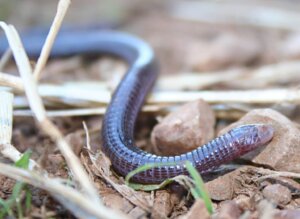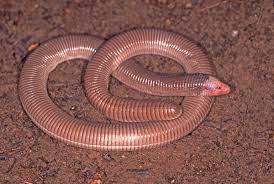Learn All About Worm Lizards!

Some animals are rather strange in appearance, but have adapted to survive in their particular environment. Among reptiles, there’s a particular group that’s similar to the common earthworms. Their scientific name is amphisbaena, but there’s a much more fun name that they’re known by: worm lizards! No, they aren’t mythological creatures! Keep reading and we’ll tell you all about them!
They belong to the Squamata order and the Amphisbaenia infra order, which consists of about six families and 195 species. They’re scaly reptiles with a life of burrowing that reduces their chances of encountering humans. Here we’ll bring you a complete guide to this peculiar group. Don’t miss it!
Habitat and distribution of worm lizards
Worm lizards are fossorial, so they live buried in the ground in self-made tunnels. They can be found throughout most of the world, in neotropical, Afro-tropical, and Mediterranean regions. They’re present in Europe, Africa, Asia Minor, and America (North, Central, and South America).
Worm lizard characteristics
These animals resemble earthworms, thanks to their elongated and slender body, adapted to a fossorial life. The head is the part that allows them to dig into the soil. Their morphology is variable and is related to the way they carry out this process.
Their heads can be rounded, shovel-like, spatula-like, or have a vertical keel. Their skull is strong and is formed by rigid bony plates, which provide resistance to withstand blows.
They don’t have any legs and with their elongated and thin bodies they can enter confined spaces. However, there are three specimens that do have forelimbs and use them as an aid to penetrate the ground; they’re the members of the Bipes genus (Bipedidae family).
Their head and tail are similar, so it’s often called a two-headed snake, like the mythological creature. The name amphisbaena refers to their ability to move in both directions.
This animal’s body is scaly and may or may not have some shading. Generally, colorful worm lizards occupy the higher galleries nearer the surface, while those with little or no pigment are found in the deeper ones. In addition, their tail may be short and thick, or elongated and thin.
It has small eyes, as it doesn’t need them in its subterranean life. With its poor vision, other attributes are necessary for orientation and survival. Among them, we can highlight their ability to perceive sounds and vibrations from the ground. In addition, they are endowed with a chemical sense.
Behavior
The most outstanding characteristic of this type of reptile is its fossorial and burrowing behavior, which is why they build tunnels in the ground. It also has morphological adaptations to carry out this lifestyle. The tegument is soft to reduce friction and allow displacement.
Like other reptiles, they undergo a process of ecdysis or molting of the skin. This is constant, as, due to their subterranean life, they suffer periodic wear of the integument.
They’re very active during the rainy season. When temperatures are milder, they can reach the surface and remain under rocks, logs, or other objects. This behavior is due to the fact that they’re ectothermic animals, which regulate their body temperature with the help of the external environment.
They obtain heat by contact. In this way, they perform vertical migrations in the substrate, according to the environmental temperature and the seasons.
Among the defense strategies against predators, we must mention the so-called caudal autotomy, which is nothing more than the voluntary detachment of the tail. This is a very useful strategy, as it gives them time to flee. They also use the tail display or the escape jump.
The amphisbaena is a very successful predator, due to the fact that it’s endowed with strong jaws and teeth. In general, its carnivorous diet consists of insects and their larvae. These include termites, ants, cockroaches and other types of animals such as earthworms. However, it can also include small vertebrates, such as rodents. Prey is detected by smell and bitten into pieces.
Reproduction

Most species of amphisbaena have oviparous reproduction, i.e. they lay elongated eggs. However, their clutches are few in number (between 2 and 6). There are also ovoviviparous specimens, which retain the eggs inside their bodies until hatching, and viviparous specimens, if they’re also nourished by maternal tissues. However, it’s difficult to distinguish between the latter two individuals.
The sexual cycle of the amphisbaena is seasonal, with a preference for warm and rainy seasons. Juvenile maturation is rapid, which compensates for the low number of clutches to ensure reproductive success.
In particular, the amphisbaena is a very particular and little-known reptile. It has a morphology that has adapted to its subterranean life. Under the ground, there’s a whole new world to discover, with fascinating creatures like the one we’ve introduced you to today.
All cited sources were thoroughly reviewed by our team to ensure their quality, reliability, currency, and validity. The bibliography of this article was considered reliable and of academic or scientific accuracy.
- Andrade, D., Nascimiento, L., & Abe, A. (2006). Habits hidden underground: a review on the reproduction of the Amphisbaenia with notes on four neotropical species. Amphibia-Reptilia, 27, 207-217.
- Carvalho, M. & de Almeida, J. (2019). Amphisbaenia: Adaptações para o Modo de Vida Fossorial. Revista Brasileira de Zoociencias, 20(2), 1-30.
- Gans, C. (2005). Checklist and bibliography of the amphisbaenia of the world. Bulletin of the American Museum of Natural History, 289,1-130.
- Manhrdt, C., Beaman, K., Valdez-Villavicencio, J., & Papenfuss, T. (2022). Bipes biporus (Cope). Catalogue of American Amphibians and Reptiles. Recuperado el 03 de enero de 2023, disponible en: https://repositories.lib.utexas.edu/bitstream/handle/2152/116238/0930Bipesbiporus.pdf?sequence=2
This text is provided for informational purposes only and does not replace consultation with a professional. If in doubt, consult your specialist.